Streamlit Text Area
st.text_area displays a multi-line text input widget
It is used when we want users to enter large amounts of text such as feedback, descriptions , comments, e,t,c
Need a Streamlit developer? Click here
Syntax
st.text_area(label, value=””, height=None, max_chars=None, key=None, help=None, on_change=None, args=None, kwargs=None, *, placeholder=None, disabled=False, label_visibility=”visible”, width=”stretch”)
| Parameter | Type | Default | Description |
|---|---|---|---|
| label | str | Required | The label or title displayed above the text area. |
| value | str | "" | Default text that pre-fills the text area. |
| height | int | None | Sets the height of the text area in pixels. |
| max_chars | int | None | Maximum number of characters a user can enter. |
| key | str or int | None | A unique key to identify the widget, useful when using multiple widgets. |
| help | str | None | Tooltip text displayed when hovering over the widget. |
| on_change | callable | None | A function or callback triggered when the text changes. |
| args | tuple | None | A tuple of positional arguments passed to the on_change callback function. |
| kwargs | dict | None | A dictionary of keyword arguments passed to the on_change callback function. |
| placeholder | str | None | Shows a hint inside the text area until the user starts typing. |
| disabled | bool | False | If True, the text area becomes read-only and users cannot type. |
| label_visibility | str | "visible" | Controls the label display: "visible", "hidden", or "collapsed". |
| width | str | "stretch" | Defines the widget’s width. Options: "stretch" (default) or a custom CSS width like "400px". |
Basic Example
Here, we display a text area
we store user input in “input”
Then we display it
import streamlit as st
st.title("Basic Text area")
input = st.text_area("Enter your comments:")
st.write("You wrote")
st.write(input)
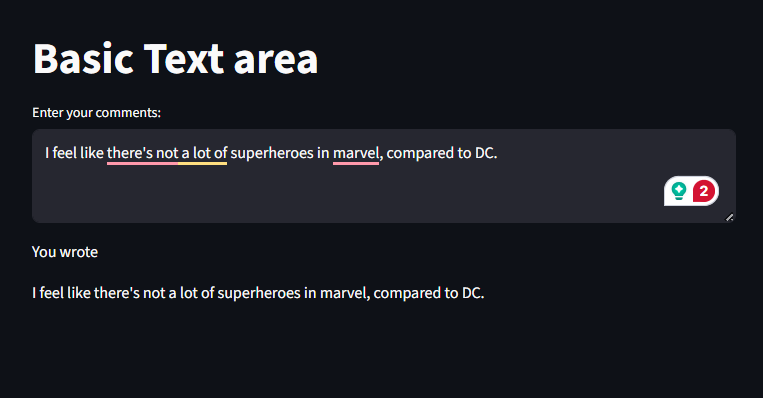
Handling Input from users
Of course we can perform actions based on what the user types.
import streamlit as st
st.title("Feedback Form")
feedback = st.text_area("Leave a feedback:")
if st.button("Submit feedback"):
if feedback:
st.success("Thanks for the feedback!")
st.write("Your feedback:", feedback)
else:
st.warning("Please enter a feedback before submitting")
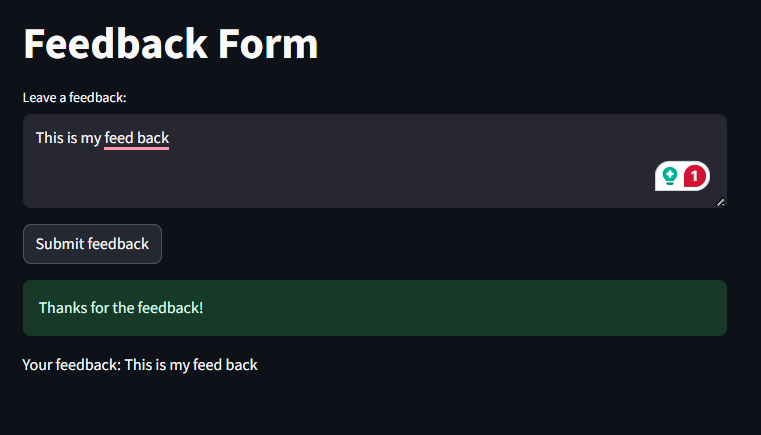
Controlling Parameters
we can control the size, default values, placeholders, label e.t.c of the st.text_area
value: Pre-fills the text area.
height: Makes the box taller.
placeholder: Shows hint text.
import streamlit as st
st.title("Customizing Text Area")
bio = st.text_area(
label="Say something about yourself",
value = "Hi, i'm learning streamlit!",
height = 200,
placeholder = "Write something interesting about yourself..."
)
st.write("Bio")
st.write(bio)
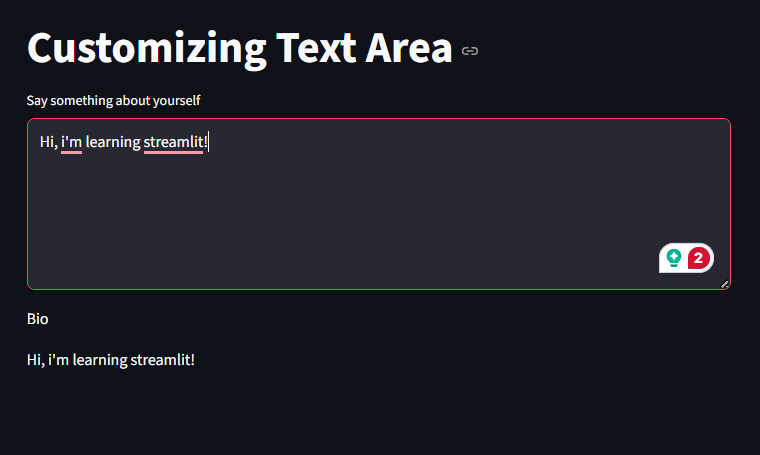
Multi-Line Text
By default, st.text_area supports multiple lines, which makes it ideal for writing paragraphs, notes, or code.
import streamlit as st
st.title("Code Snippet Input")
code = st.text_area(
"Paste your Python code here",
height=200,
placeholder="Type or paste your Python code..."
)
if st.button("Run Code"):
st.write("You entered the following code:")
st.code(code, language="python")
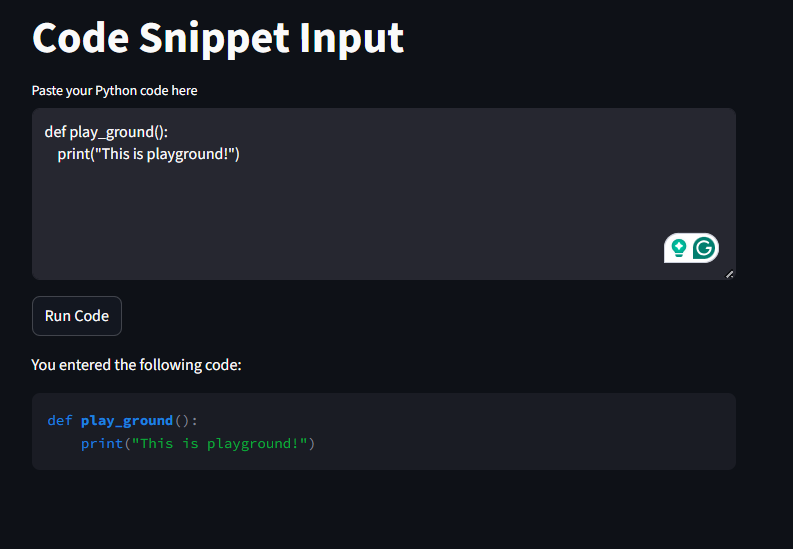
Character Counters and Limits
st.text_area has the max_chars parameter, which restricts the number of characters.
Note you might have to press ctrl + enter after typing in the text area in other to trigger the follow up code
import streamlit as st
st.title("Limited Text Area")
description = st.text_area(
"Write your short bio:",
max_chars=100,
placeholder="Maximum 100 characters allowed"
)
st.write(f"Characters used: {len(description)}/100")
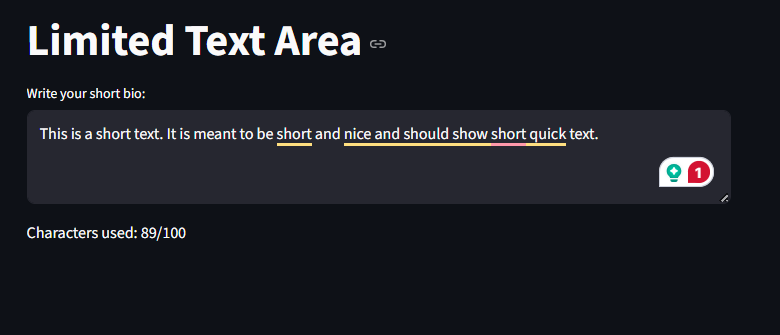
Integrating with other widgets.
we can use st.text_area with many other widgets in streamlit.
:
import streamlit as st
st.title("Text Analyzer")
text = st.text_area("Enter some text to analyze")
option = st.selectbox("Choose an analysis type:", ["Word Count", "Character Count"])
if st.button("Analyze"):
if option == "Word Count":
st.write(f"Word Count: {len(text.split())}")
else:
st.write(f"Character Count: {len(text)}")
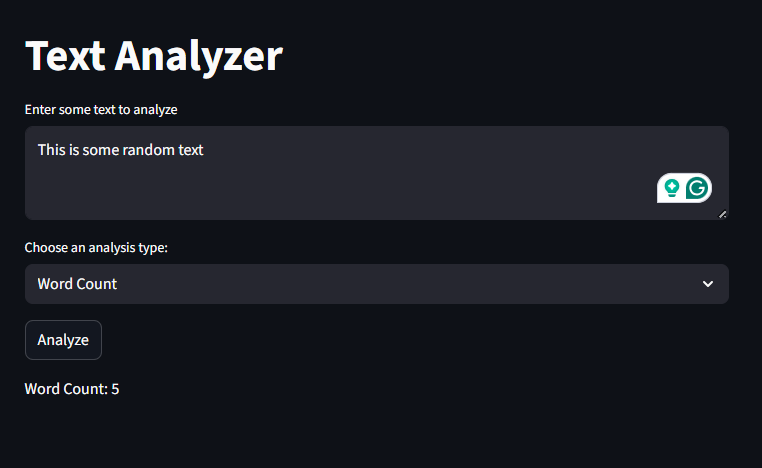

st.text_area is powerful because:
It supports multi-line input.
It works well with real-time updates.
It integrates seamlessly with other Streamlit widgets.
Learn more about Streamlit: Click here
Watch videos on Streamlit:
